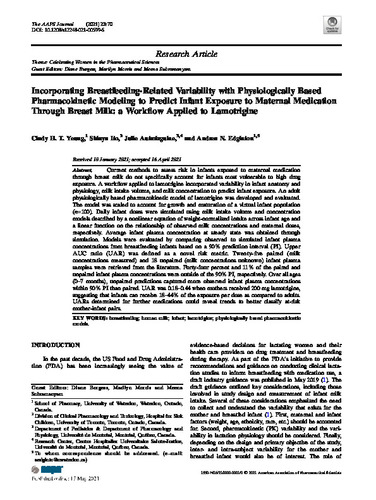| dc.contributor.author | Yeung, Cindy Hoi Ting | |
| dc.contributor.author | Ito, Shinya | |
| dc.contributor.author | Autmizguine, Julie | |
| dc.contributor.author | Edginton, Andrea N. | |
| dc.date.accessioned | 2023-03-21 18:54:20 (GMT) | |
| dc.date.available | 2023-03-21 18:54:20 (GMT) | |
| dc.date.issued | 2021-05-17 | |
| dc.identifier.uri | https://doi.org/10.1208/s12248-021-00599-5 | |
| dc.identifier.uri | http://hdl.handle.net/10012/19219 | |
| dc.description | The version of record of this article, first published in The American Association of Pharmaceutical Scientists Journal (The AAPS Journal), is available online at Publisher’s website: http://dx.doi.org/10.1208/s12248-021-00599-5 | en |
| dc.description.abstract | Current methods to assess risk in infants exposed to maternal medication through breast milk do not specifically account for infants most vulnerable to high drug exposure. A workflow applied to lamotrigine incorporated variability in infant anatomy and physiology, milk intake volume, and milk concentration to predict infant exposure. An adult physiologically based pharmacokinetic model of lamotrigine was developed and evaluated. The model was scaled to account for growth and maturation of a virtual infant population (n=100). Daily infant doses were simulated using milk intake volume and concentration models described by a nonlinear equation of weight-normalized intake across infant age and a linear function on the relationship of observed milk concentrations and maternal doses, respectively. Average infant plasma concentration at steady state was obtained through simulation. Models were evaluated by comparing observed to simulated infant plasma concentrations from breastfeeding infants based on a 90% prediction interval (PI). Upper AUC ratio (UAR) was defined as a novel risk metric. Twenty-five paired (milk concentrations measured) and 18 unpaired (milk concentrations unknown) infant plasma samples were retrieved from the literature. Forty-four percent and 11% of the paired and unpaired infant plasma concentrations were outside of the 90% PI, respectively. Over all ages (0–7 months), unpaired predictions captured more observed infant plasma concentrations within 90% PI than paired. UAR was 0.18–0.44 when mothers received 200 mg lamotrigine, suggesting that infants can receive 18–44% of the exposure per dose as compared to adults. UARs determined for further medications could reveal trends to better classify at-risk mother-infant pairs. | en |
| dc.description.sponsorship | Canadian Institutes of Health Research (CIHR); Project Grant; Award Number: PJT-159782 || Canadian Institutes of Health Research (CIHR); Frederick Banting and Charles Best Canada Graduate Scholarships Doctoral Award (CGS-D), a Canada Graduate Scholarship to Honour Nelson Mandela; Award Number: DF2-171445 | en |
| dc.language.iso | en | en |
| dc.publisher | Springer Nature | en |
| dc.relation.ispartofseries | American Association of Pharmaceutical Scientists Journal;70 | |
| dc.subject | breastfeeding | en |
| dc.subject | human milk | en |
| dc.subject | infant | en |
| dc.subject | lamotrigine | en |
| dc.subject | physiologically based pharmacokinetic models | en |
| dc.title | Incorporating Breastfeeding-Related Variability with Physiologically Based Pharmacokinetic Modeling to Predict Infant Exposure to Maternal Medication Through Breast Milk: a Workflow Applied to Lamotrigine | en |
| dc.type | Article | en |
| dcterms.bibliographicCitation | Yeung, C.H.T., Ito, S., Autmizguine, J. et al. Incorporating Breastfeeding-Related Variability with Physiologically Based Pharmacokinetic Modeling to Predict Infant Exposure to Maternal Medication Through Breast Milk: a Workflow Applied to Lamotrigine. AAPS J 23, 70 (2021). https://doi.org/10.1208/s12248-021-00599-5 | en |
| uws.contributor.affiliation1 | Faculty of Science | en |
| uws.contributor.affiliation2 | School of Pharmacy | en |
| uws.typeOfResource | Text | en |
| uws.peerReviewStatus | Reviewed | en |
| uws.scholarLevel | Graduate | en |

